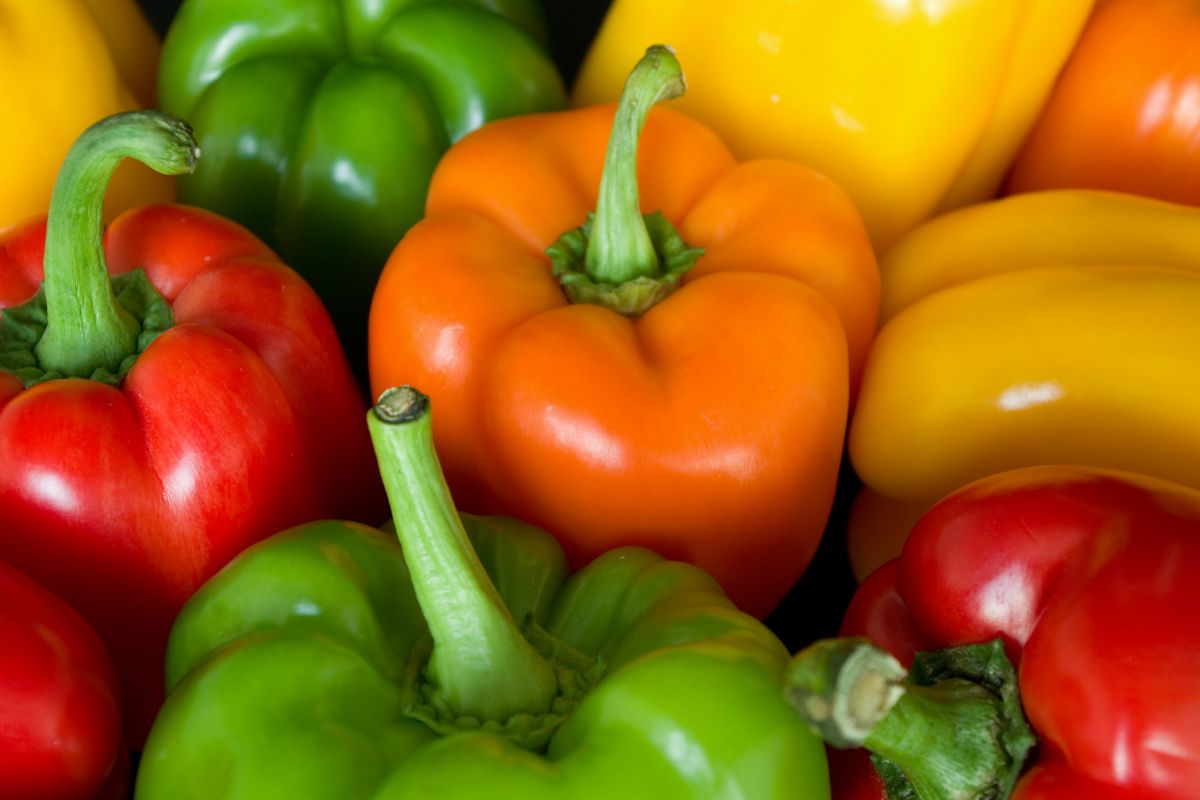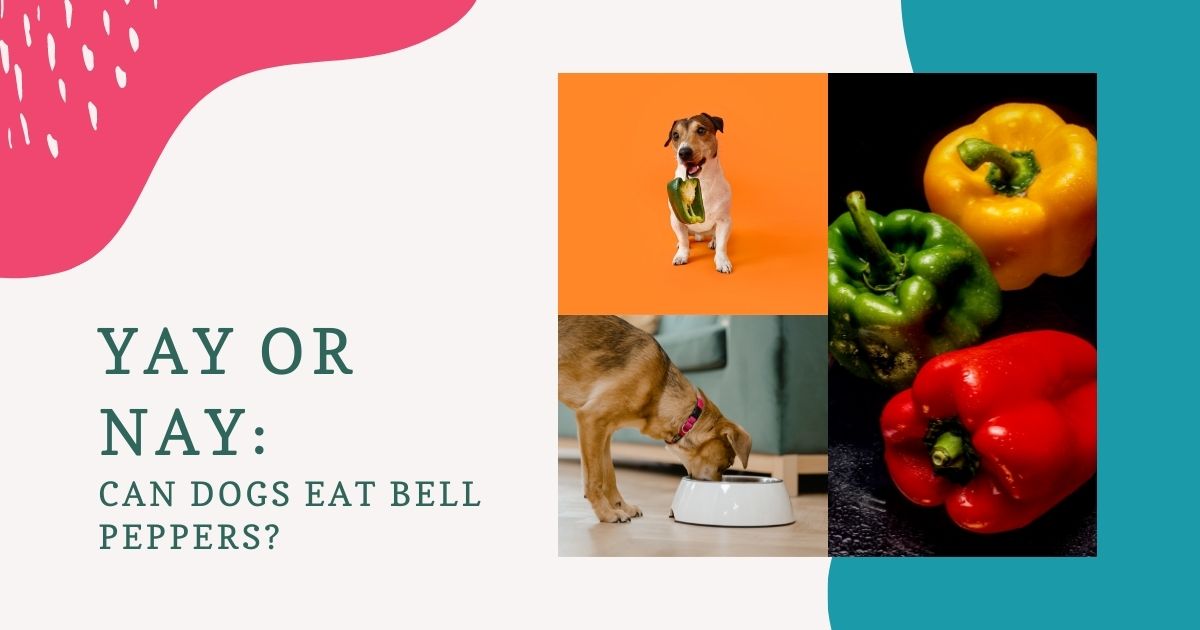Bell Peppers and Dogs
Can dogs eat bell peppers? If you like bell peppers, you may be wondering if you can feed them to your dog. Bell peppers are extremely healthy for humans and provide numerous benefits, but can the same benefits apply to dogs?
This light and crisp vegetable is completely safe to feed to your dog. Do you want to know more about bell peppers and dogs? Let’s get started.

Does Color Matter?
Can dogs eat green bell peppers? You can find the vital vitamins and elements that are helpful to a dog’s health in any color bell pepper. Though, the red kind is the healthiest. They are the greatest to feed your dog because they have the most vitamins and antioxidants.
Can Dogs Eat Yellow Bell Peppers?
Yes. All bell peppers, including yellow peppers, are safe for dogs to consume. Red peppers, on the other hand, are the healthiest. If you’re giving your dog peppers for nutritional reasons, it’s best to provide them with the most beneficial variety. Yellow bell peppers, on the other hand, you can give to dogs as a treat.
Furthermore, you must take certain precautions, as dogs are carnivores by nature and are not supposed to eat vegetables as a primary source of nutrition. Bell peppers, for example, you should give to dogs in moderation (a few slices a day). To avoid choking, remove the stem and seeds.
You should also take other safeguards. Do not feed your dogs vegetables containing pesticides or other potentially dangerous compounds. If you choose to feed your dog bell peppers, thoroughly wash them beforehand.
Can Dogs Eat Orange Bell Peppers?
Yes! As previously stated, dogs may eat all sorts of bell peppers, even orange ones. On the other hand, dogs should eat food that you carefully prepare for their health and well-being.
Feeding your dog too many veggies or other things that do not qualify as dog food is not advisable. Instead of focusing on what dogs can eat, owners should concentrate on what dogs should eat.
Do Dogs Get Health Benefits From Eating Bell Peppers?
Vegetables in moderation are beneficial to your dog, especially if it is prone to fat or constipation. Bell peppers, in particular, are a fantastic source of nutrients. They are high in carotenoids, antioxidants, and vitamins A, C, and E. These components are important for your dog’s health.
Bell peppers are an excellent method to enrich your dog’s diet, especially if you offer her raw meat instead of kibbles (BARF diet). Use bell peppers only as a reward because processed dog food provides all the vitamins and minerals your dog requires to flourish.
Bell peppers contain vitamins, minerals, phytonutrients, and antioxidants that are beneficial to dogs. Can dogs eat sweet bell peppers too? They can; vitamins A, B6, and C, as well as beta carotene, are all present in sweet peppers.
These nutrients support a dog’s immune system and the health of its nails, teeth, and coat. Sweet bell peppers come in various hues. The red bell peppers are nutritious powerhouses that owners should consider feeding themselves and their pets over other color options.
Red peppers spend more time on the vine than green, yellow, or orange peppers. This allows them to absorb more nutrients from their surroundings. Don’t let the bell pepper color determine whether you share a few slices with your dog. They all contain fiber, water, and nutrients that will help your canines in the long run.

How Many Bell Peppers are Safe for Canines to Eat?
Dogs are primarily carnivores; therefore, they don’t require a lot of vegetables in their diet. Bell peppers, like any other vegetable, can disrupt your dog’s digestive tract, causing diarrhea and, in some circumstances, vomiting.
When introducing bell peppers, start with a small slice and gradually increase the amount. You can offer your dog 1-3 medium pieces each day if it is little, or up to half a bell pepper if it’s a large dog, depending on its size and nutrition. However, don’t make them your dog’s go-to food; dogs require variety in their diets to receive all the necessary vitamins and nutrients.
Treats should not account for more than 10% of your dog’s daily food intake; thus, each portion should be smaller than a slice if you use bell peppers as treats.
How to Feed Bell Peppers to Dogs Safely?
Can dogs eat bell peppers cooked? If you decide to give your dog bell peppers, ensure they are clean and free of seasonings or additives before giving them to the dog. You can serve it raw or cooked, depending on your preferences for feeding your dog.
If your dog doesn’t enjoy the taste of bell peppers, cook them for a few minutes before feeding them to it. Because dogs normally consume food from their natural habitat, this can make the flavor more enticing and easy to chew.
You can slice bell peppers and give them as little rewards if necessary. Your veterinarian may recommend it because it is easier for some people to determine whether or not their dog is allergic to hot spices you may find in many other veggies, such as onions and garlic. Read our article and find out Can Dogs Eat Avocado?
Serving Suggestions
Can dogs eat raw bell pepper? Many dogs will cheerfully eat raw bell pepper, but some are less enthusiastic. If you’re attempting to feed your dog bell pepper to improve their health and replace less healthy treats, you may have to experiment with a few different serving ideas before you find one that they like:
For a satisfying and healthful mini-meal or snack, sauté a few slices of bell pepper with a little fish or chicken. Cover bell pepper bits in peanut butter and serve as a reward during training sessions.
Finely dice the bell pepper and add it to your dog’s wet or dry food at mealtime. When it comes to bell peppers, your dog may have a color preference. After all, their textures and flavors are slightly different. So, give each hue a chance and see which one your dog prefers.
Keep in Mind the Exceptions
Can dogs eat red bell peppers? Red and sweet bell peppers are safe for dogs to consume. Spicy peppers, on the other hand, are a different story. Dogs can eat a small amount of spicy pepper with no negative consequences. On the other hand, spicy peppers contain a chemical known as capsaicin, which might irritate a dog’s digestive tract.
A dog consuming too much hot pepper may develop diarrhea, indigestion, and dehydration. As a result, it’s best to stick to the sweet stuff and avoid giving your dog chili peppers.
Bell pepper peels are also difficult to digest for dogs. It is fine to feed them a slice or two of pizza. However, if you’re going to add half a bell pepper to your dog’s meal, steam it first. This will soften the skin and make the meal more digestible for your dog. You should never give your dog peppers cooked with garlic, onions, or spices, so give your dog plain peppers.

Conclusion
Can dogs eat bell peppers? Yes, bell peppers are okay for dogs if you clean them and do not give them in large quantities. When giving your dog veggies like bell peppers, it’s critical to supply water because dehydration can cause stomach problems like diarrhea and vomiting.
Due to their differing digestive systems, dogs experience dehydration faster than humans when eating meals containing little liquid. Depending on the cultivar, bell pepper trees yield fruit with light green skin in white, yellow, orange, or red hues.
Though some breeds may be allergic to these vegetables, most mammals (including canines) will not experience allergy reactions after eating them unless they have an allergen-containing pesticide from spraying.
Before adding bell peppers or any other new item into your dog’s diet, it’s always a good idea to consult with your veterinarian since they have a greater grasp of your dog’s health.

